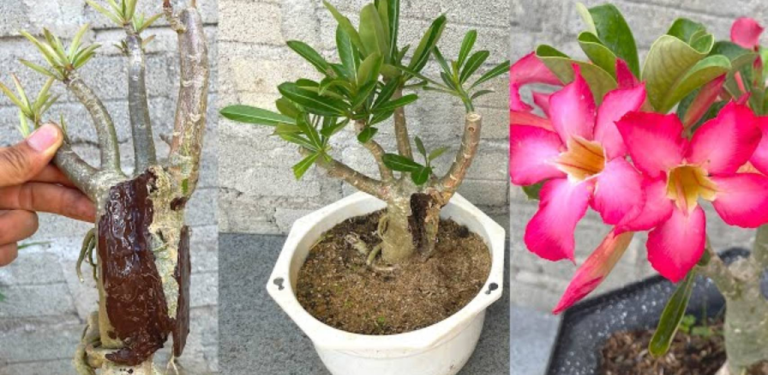ADVERTISEMENT
- Soak a cotton swab in the rice water and wipe the orchid leaves, removing germs and insects.
- Spray the leaves with the rice water using a spray bottle.
- Place the orchid in a bowl and pour the rice water over the roots. Let it soak for an hour.
- Drain off excess water, dry and repeat fertilization every 14 days.
- Note: You can freeze the rice water to always have fertilizer available. Thaw and wait for the water to reach room temperature before using.
Expected Results: - After 2-3 weeks, the leaves will be greener and new roots will grow.
- The orchid will bloom profusely.
Good luck!
4th
Desert Rose Characteristics: - Scientific Name: Adenium obesum
- Height: Up to 2 meters in the ground, less in a pot; ideal for bonsai.
- Foliage: Elongated, medium green, hardy; deciduous.
- Climate: Subtropical to tropical, arid; tolerates cold nights.
- Soil: Prefers well-drained, sandy soil.
- Position: Sunny, open location; light shade from midday sun.
- Flowering: Individual rose-like flowers in a variety of colors and combinations.
- Feeding: Long-term controlled-release fertilizer, used sparingly.
- Watering: Water in hot, dry conditions; good drainage is essential. Do not water during dormant period.
Appearance and Characteristics: - Caudex: Swollen trunk that stores moisture, similar to a belly.
- Leaves: Small and medium green.
- Flowers: Similar to those of the oleander, with five petals around a central yellow “eye”. Colors from pink to deep red, with variations and combinations. Average flower size: 5 cm.
How to Grow the Desert Rose: - From seeds: Can be complicated due to the variability of the seedlings.
- From cuttings: To obtain plants true to the original type.
Planting in the Garden:
- Sunny Position: Light midday shade in tropical and arid areas.
- Level of Caudex: Base of caudex at ground level or slightly above.
- Soil: Well drained with gravel, but tolerates richer soil.
- Fertilization: Controlled release fertilizer during soil preparation.
Potting: - Terracotta or Porous Clay Pot: Drains well and dries quickly.
- Pebble or Clay Ball Base: Improves drainage.
- Potting Mix: Use high quality cactus and succulent mix.
- Plant Placement: Base of caudex on top or slightly above the mix.
- Initial Protection: Place in a sheltered location for a week before exposing to sun.
- Light Midday Shade: Minimizes leaf scorch.
Growing as Bonsai: - Shallow Bonsai Pot: Proportional to the size of the plant, with sufficient drainage holes.
- Root Trimming: So that the base of the caudex is above the rim of the pot.
- Pot Filling: With premium bonsai mix.
- Watering and Settling: Water well to settle the mix.
- Top Trimming: Begins the shaping process.
- Initial Protection: Protected location for a few weeks before gradually exposing to the sun.
- Light Midday Shade: If possible.
Desert Rose Care:
- Regular Watering: Especially during hot, dry times.
- Water Soluble or Liquid Fertilizer: In spring and summer to encourage flowering.
- Annual Fertilization: Controlled release fertilizer around plants in the garden and pots, used sparingly.
Desert Rose Pruning: - In the Garden: Light pruning in the dry season to maintain shape and prevent infection.
- Bonsai: Trim tips every few months, taking into account flower placement.
Diseases and Pests: - Common Pests: Aphids and mealybugs
ADVERTISEMENT
Pages: 1 2
